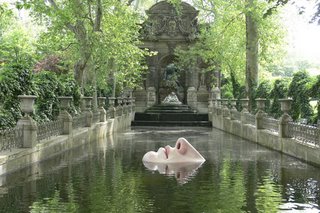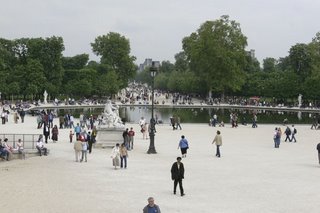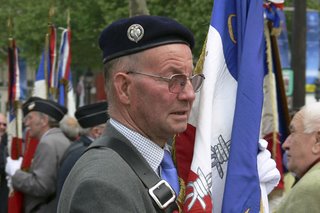
It was a beautiful Sunday morning in Paris when we awoke. We got up, showered and since we were feeling a bit lazy we thought we would just head downstairs to the hotel “basement” for breakfast. Now as some know breakfast in your hotel can be a risky venture and over the years we have developed a sort of sixth and a half sense about these things – a skill that unfortunately deserted us that morning. The plate of bread items (croissant, baguette etc) was OK but the coffee pretty atrocious and the juice squeezed out of something orange but not necessarily fruit-oriented.
(A word about breakfast in Paris. Unlike Italy where many bars will serv e a large assortment of morning pastries, our brief experience in Paris was that most bars serve very little in the way of morning sweets: at best a simple plain croissant and maybe a slice of baguette with butter might be available on the counter. For pastries one needs to go to a boulangerie. The problem is that many of the boulangerie don’t serve coffee; they serve bread and pastries only, rather like the pasticcerie or the panificio or fornaio in Italy. On Tuesday we would discover a remarkable exception to this rule, Coquelicot, located in the funky, cool part of Paris known as Montmarte.)
It was a gorgeous morning and with the tiny glitch of a tepid breakfast behind us we left the hotel and found ourselves standing on the curb at the corner of rue des Volontaires and rue de Vaugirard wandering what to do.
What would you do on a Sunday in Paris?
We decided to head toward Notre Dame – why I really don’t know. Although we had a handful of Metro tickets we walked up the rue de Vaugirard. I read somewhere that Vaugirard is the longest street in Paris and I think we pretty much walked the length of it. But it was worth every step because somewhere along our path we came upon what appeared to be a small garden and thought we might just stroll through it.

As it turned out this was the fabulous Luxembourg Gardens (Jardin du Luxembourg), a huge green space filled with flowers in bloom, sculptures of all types for every imagination as well as sculptured trees), cool fountains (my favorite is the Medici fountain with the face popping up out of the water), stunning views of the Pantheon and the Observatoire, all serving as a superb backdrop for people sitting and reading or watching other people, relaxing (doing what appeared to be tai chi maybe), sunning, talking, playing boules, and one group working on their swordplay (really), families, couples of every age seemed to be everywhere, what a grand spectacle this was. And imagine this happens probably every Sunday! This we thought was truly civilized behavior.
From the gardens we continued wending our way to the Seine and soon found ourselves standing along with hundreds (maybe thousands?) of others at the doorway to Notre Dame (Mon-Fri, 8:00-7:00, Sat, 8:00-12:30 and 2:00-7:00, free). We went in just as mass had just started so we just stopped to one side of the nave and listened to some sweet music for a few minutes before shuffling out. Oh and keep an eye out for a bronze star on the pavement in front of the west door of the cathedral. This is known as kiloemtre zero, the spot from which all main road distances in France are calculated.

Notre Dame is on the tiny Isle de Cite, in the middle of the Seine, the birthplace of the city. We strolled from one side of the island to the other, passing a small little flower market set up for Sunday traffic, and back again to Notre Dame. Almost in the street, at the far western end of the small square in front of the cathedral is a small set of stairs leading down toward the crypte archeologiqeu (Tues-Sun, 10:00-6:00, admission). This is one cool exhibition. Here you can go beneath the plaza above you and see some of the excavated remnants of the original Paris. There is actually much to see and digest in the cool darkness of the crypte; the exhibition is well put together with great lighting and lots of multi-lingual signage for those like us who are French-challenged. Plus there were few tourists down there even on a Sunday.
After climbing up out of the crypte we walked to the eastern end of Notre Dame, skirting their small garden on one side and the Seine on the other. There we found the haunting and disturbing La Memorial de la Deportation (daily 10:00-12:00 and 2:00-5:00, free). Since it was closed for lunch we thought we too might have something to eat ourselves so we crossed to the left bank of the Seine (the left bank being essentially the south side of the river) and sat outside at the wonderful little Café Leffe where we had a delicious lunch. (The café is located just across from Notre Dame and the Petit Pont, almost on Quai de Montbello, at 41 rue de la Boucherie, 75005, www.cafeleffe-notredame.com).

After lunch we crossed the Pont Au Double back on to the tiny island and headed fro the Deportation Memorial. We had been here some years ago when we were in Paris the last time and were just awed by the place, for this is unlike anything else you might see in the city. You walk down a narrow flight of steeps and find yourself in a small courtyard where the walls and pavement is all made from the same rock and stone. One then enters the crypte through a narrow defile and is faced with a stark reminder of this very dark part of French history: in front of you, enmeshed in black walls, black floor and black ceiling, are some 200,00 points of light representing the 200,00 French men, women and children who died in Nazi concentration camps. (Near the Bir Hakeim metro stop, close to the Eiffel tower, is a memorial to the more than 32,000 Parisian Jews who were herded into the cycle racetrack which was once located there before being deported to concentration camps. Virtually none of them survived.)
So if you ache for historical understanding by all means before you see anything else in Paris head for the Isle de Cite. What better way to begin your trip, your tour, and your experience of Paris, than to start at the city’s creation? It just might help you get put everything else you will see in perspective.
From the Memorial we walked toward the other tiny island, Isle St. Louis, which is primarily residential today, drawn by the unmistakable sounds of a jazz quartet. Sure enough on the small footbridge connection the two islands four guys were just finishing up a set playing some serious jazz for anyone who would listen and maybe buy one of their CDs. We stopped and took in the great music until they wrapped up and then we too headed off across to the right (“north”) side of the river. Our objective was the Arc de Triomphe.

We crossed over to the Hotel Ville, the city hall, whre they had a display of "star" art scattered around in front of the entrance. Much like the world-famouse "cow" art these were stars and some were actually quite imaginative.
We strolled along the river until we came to the Louvre and then cut into the courtyard of the museum, passing the no-longer-controversial glass pyramids, and continued toward the Tuileries Gardens. It was such a grand day to be there and it we felt especially fortunate to spend our first day in Paris on a Sunday, truly the way to begin any tour of the city. Everyone is out, many if not most shops and business are closed and the city is truly alive with just enjoying itself, or so it seemed.

We walked through the Tuileries, passing numerous people relaxing amidst the imaginative sculptures, coming to the fountain where children were racing their toy sailboats – not always successfully I might add. Many of the kids seemed to be relying on the skills of their parents to retrieve a boat, skills not always available to ever the most dedicated parent it would seem since many of the boats languished in the middle of the fountain until the wind caught them and would then send them careening to the opposite side form where the parent and child happened to be standing thus causing a frenetic run to that side just to see the boat caught by another gust of wind taking it in the opposite direction. Ah the sweet joys of youth.

We crossed from the Tuileries to the place de la Concord. Separating the Tuileries from the eastern end of the Champs-Elysees, and surrounded by a constant stream of traffic on all sides, the place de la Concorde is a tiny oasis, a unique window on history from ancient Egypt to revolutionary France. In the center of the place is a gold-tipped obelisk taken from the temple of Ramses at Luxor, Egypt. This marks the spot where the guillotine stood during the early years of the French revolution, and where some 1300 people were executed, among them the king Louis XVI, Marie Antoinette, and even many of the revolutionaries themselves such as Danton and Robespierre. Today it serves as mainly a perfect place to appreciate the grandeur of present-day Paris, with a sweeping vista covering the Louvre at one end to the Arc de Triomphe at the other.

This day in particular it served yet another purpose. As we crossed over to the island from the Tuileries we noticed large groups of people one clustered around each of the two bronze fountains flanking the obelisk. The closer we got to the center of the place the more readily apparent it became that there was a photo shoot of a wedding party taking. We finally caught sight of the bride and groom . . . and then another bride and groom and another and another and another and another, some 15 or more wedding couples, all Asian were having their photos taken on the place de la Concorde! Were they all related? Had there been some mass marriage ceremony held earlier somewhere in Paris? Were the weddings arranged? Did Sheila have Brad’s child after the crash impaired her vision and her father had the ingrown nail treatment? Did it matter? It was one of the coolest things we have ever seen – in fact as we thought on it when was the last time you saw more than one bride and groom together at a wedding let alone 15!?

From the place de la Concorde we strolled up the champ Eysees, pas the enormous Grand Palais and it’s tiny sister, the Petit Palais. We soon struck the main shopping district along the Champs-Elysees and as we neared the Arc de Triomphe noticed a group of rollerbladers being escorted down the boulevard, heading west, and the longer we watched the more rollerbladers there were, hundreds maybe several thousands, rather like runners in a marathon? It was the largest number of rollerbladers either one of us had ever seen in one place. I n fact I would go so far as to say that there were more rollerbladers in that pack than I have seen in my entire life! Amazing.
As the last of the rollerbladers headed west we continued walking east toward the place Charles-de-Gaulle, also known as the place de l’Etoile (etoile meaning star) and the overpowering, overwhelming, enormous Arc de Triomphe (daily April-Sept, 9:30am-11:00pm and Oct-Mar, 10:00am-10:30pm; admission).

As we approached the end of the Champs-Elysees, standing in the shadow of the Arc, we found ourselves in them midst of a large group of flag-carrying, elderly ladies and gentlemen, with many of the men wearing little garrison caps (as we called them in the Marines) similar to the caps worn by the American Legionnaires in the United States. They were all milling around chatting amongst themselves – swapping war stories one assumes or talking about their grandchildren -- and we wondered if we had just missed some ceremony or another. I took a number of photos and a few minutes later we walked down the stairs into the underground passage that leads beneath the traffic to the place and the entrance to the Arc. We had been to the top of the Arc in 1998 – outstanding views I might add -- and decided we didn’t need to climb there today so we exited onto the small place.

When we came out into the sun we soon discovered that something was afoot at the Tomb of the Unknown Soldier located directly beneath the Arc itself. And sure enough after some time waiting by a barricade soldiers began forming, the band marched in and soon afterwards the parade of veterans with all their flags flying, the same veterans we had seen gathering on the Champs-Elysees just a half or so earlier.
After the veterans had entered the space beneath the Arc, forming around the tomb, a few words were said, the band played and the ceremony was over. We wondered why the procession on this particular Sunday and speculated that it was the first Sunday after the actual day the war ended in Europe, May 8 I believe. But we really don’t know. The reason of course is unimportant I suppose. It was quite moving and pointed our thoughts straight at yet another slice of French history: the controversial role France played during the Second World War.
As the people drifted away from the Arc following the ceremony at the Tomb of the Unknown Soldier so we looked for the nearest metro stop. We crossed back toward the Champs-Elysees and found an entrance to the metro. We hopped on the no. 6 line (light green) and got off at the Bir Hakeim station, the closed stop to the Eiffel tower. We strolled over to the tour Eiffel, walked beneath the four piliers and as you look upward from directly beneath what was at one time the world’s tallest building, we couldn’t help but be amazed at this thing. Somewhere we read that the tower, built originally for the Paris Exposition of 1889, it was designed as just a temporary structure but it eventually became what it is today, the singular icon which represents Paris. To me I find it the epitome of what we see over and over again in Paris: an industrial object shaped with an artist’s eye for form and aesthetics. Incredible.
We left the tour and strolled through the Champs de Mars (the “martial fields). This area has always been open fields even since they were first used for training of royal troops. According to the Rough Guide, after 1789 these fields became the venue for revolutionary festivals, and by the late 19th century were the place of choice for industrial expositions, thus explaining why the Eiffel tour is presently located there. At the southern end of the fields, facing the tour is the Ecole Militaire, which was founded in 1751 to train military officers.
On our way around the ecole and heading toward our hotel we passed the very unattractive UNESCO headquarters. You know the kind of architecture I’m talking about here, built out of reinforced concrete like a military bunker and designed by someone whose work was so bad it had been rejected by the Bulgarians and East Germans in 1960s. One consolation is they have probably the world’s largest photo of the earth running alongside the fence wall of the building. It shows the earth in slices by latitudes I think, but the panels are huge. Now that is amazing. And free.
After we freshened up at the hotel we left about 8:30 and went on the search for dinner. As we exited the hotel we turned right – Al Wady’s restaurant was to the left on rue des Volontaires and this time we went the other direction up the street to the next block where we had a delicious Asian meal at La Maison du Bonheur (33 rues des Volontaires). At the end of the meal the waiter brought us two tiny cups, and poured a little sake into each. After a moment or two Susan said that she thought there was a picture at the bottom of the cup and sure enough there was – each cup had a very tiny, very graphically nude photo of a woman, a photo which could only be seen with liquid in the. Remove the liquid and it looked as if the was just a hazy marble embedded in the bottom of the cup. Risqué yes, but highly imaginative.
We concluded that some Parisians at least are quite clever indeed.
After leaving the restaurant we paused on the sidewalk while we savored the evening air. As we looked down the street toward our hotel we could see the top third of the Eiffel tour all lit up, something we had seen before with one significant difference: thousands of strobe lights were blinking all at random, giving the impression of champagne just poured into glass, sparkling, effervescent and full of promise.
Who would have ever thought we would be here in Paris right now, thinking about moving here? Not in our wildest dreams.
No comments:
Post a Comment